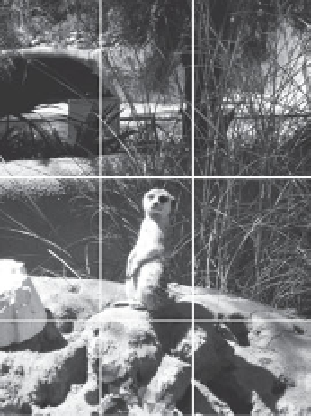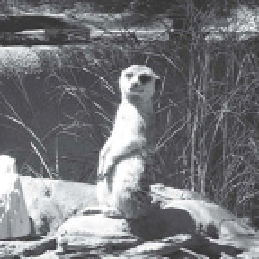Graphics Reference
In-Depth Information
by moving and removing pixels in such a way that the aspect ratios of important sub-
objects (such as faces) are preserved, while omitting information in areas that are less
perceptually important (such as large flat regions). Image retargeting techniques can
also be used for realistic, automatic
image recompositing
or
reshuffling
— that is,
the spatial rearrangement of elements of a scene.
3.5.1
Non-Uniform Warping
Initial work on retargeting simply addressed the automatic selection of a good crop-
ping rectangle for a given image or each frame of a video sequence (e.g., [
292
]).
However, as mentioned previously, cropping inevitably removes image content, and
it may not be possible to fit all objects of interest into a single cropping rectangle. An
alternative is to consider the image domain as a “rubber sheet” made up of rectangu-
lar elements. To resize the image, each element is locally deformedwhilemaintaining
connectivity with its neighbors. The idea is to maintain the original aspect ratio of
rectangles containing
regions of interest
(or
ROIs
) while squishing rectangles in
perceptually unimportant regions.
One of the first approaches of this type was proposed by Liu and Gleicher [
291
].
They used an
importance map
to determine the ROI in an image, based on an auto-
matic estimationof salience (i.e., visual importance) at eachpixel and a face detection
algorithm. Given the ROI, a simple nonlinear warp is applied to create the resized
image, as illustrated in Figure
3.24
.
Wang et al. [
536
] proposed a scheme called
optimized scale-and-stretch
that
deforms the image mesh at a much finer level and doesn't rely on a single ROI. As
before, we begin with an importance map, in this case computed as the product of
the gradient magnitude at each pixel and a saliency map. The saliency map is based
on a popular algorithm proposed by Itti et al. [
215
] that combines pixel colors and
(a)
(b)
(c)
Figure 3.24.
(a) An original image, with ROI given by the center box. (b) The ROI is uniformly
scaled to avoid distortion, while the eight rectangular regions surrounding it are warped with
piecewise linear transformations. (c) Final result.





